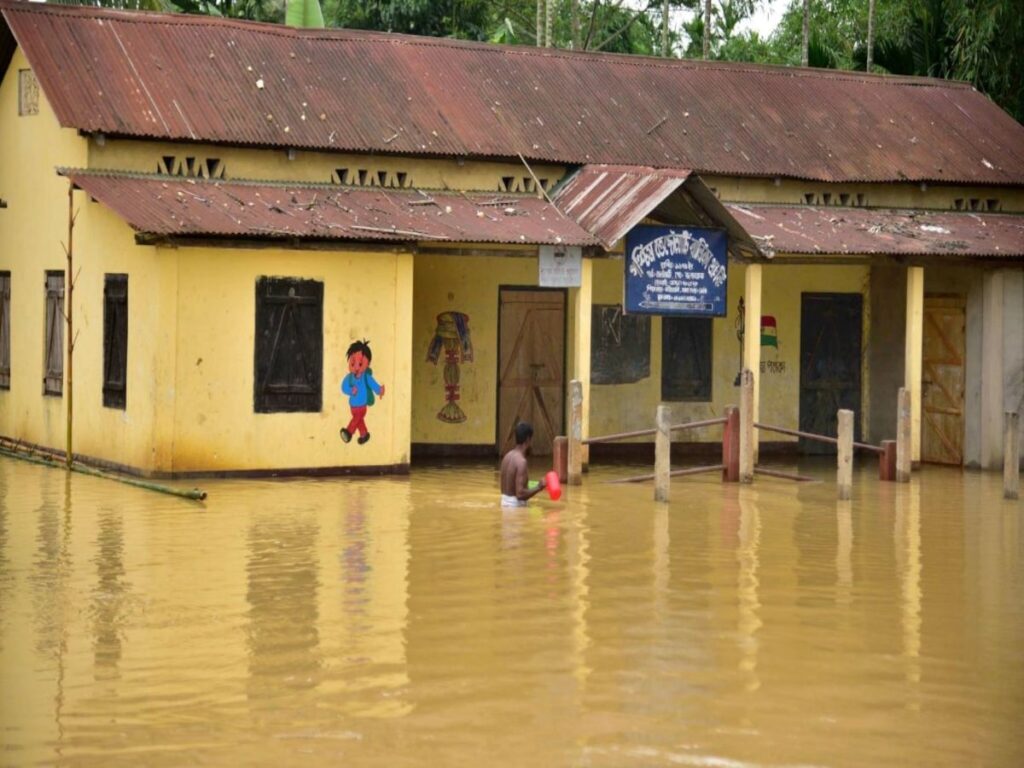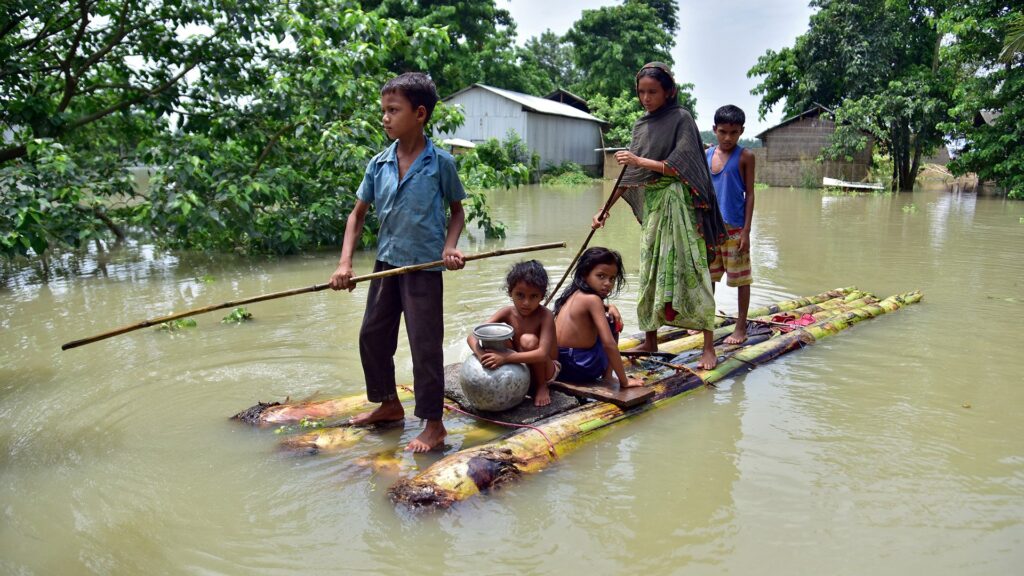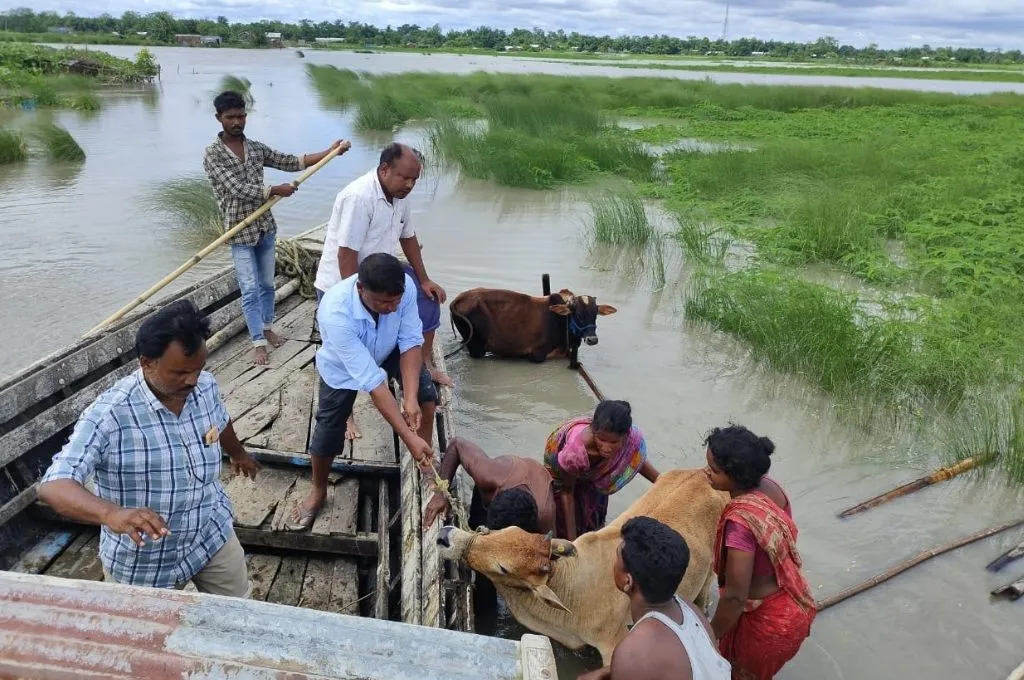
Introduction(Assam Floods)
Assam, the jewel of Northeast India, is blessed with lush greenery, mighty rivers, and rich biodiversity. However, every year, the state faces devastating floods that turn blessings into burdens. While Assam floods are often attributed to natural causes, the recurring pattern, scale, and mismanagement raise serious questions about human negligence, flawed policies, and political exploitation.
This blog delves deep into the causes, impacts, government policies, failures, the hidden benefits reaped by certain groups, foreign aid, and scientific solutions to Assam floods crisis.
https://pagead2.googlesyndication.com/pagead/js/adsbygoogle.js?client=ca-pub-7787437288479224
Causes of Assam floods
1. Natural Causes
- Heavy Monsoon Rainfall: Assam receives intense rainfall between June to September, leading to the swelling of rivers.
- Overflow of the Brahmaputra and its Tributaries: The Brahmaputra is one of the world’s most sediment-heavy rivers. During monsoons, it frequently breaches embankments.
- Glacial Melt: Melting Himalayan glaciers increase the volume of water in rivers flowing into Assam.
- Earthquakes and Landslides: Being seismically active, landslides in Arunachal Pradesh and nearby hills cause sudden river blockages that result in flash floods downstream.
2. Human-Induced Causes
- Unplanned Urbanization: Wetlands and natural drainage systems have been encroached upon, especially in Guwahati and other towns.
- Deforestation: Massive deforestation in upstream areas reduces the land’s capacity to absorb water.
- Poor Embankment Maintenance: Most embankments are decades old with poor maintenance, leading to frequent breaches.
- Sand Mining and Riverbed Degradation: Illegal sand mining disrupts river courses, causing unpredictable flooding patterns.

Impact of Floods in Assam
1. Humanitarian Crisis
- Loss of hundreds of lives annually.
- Displacement of lakhs (hundreds of thousands) of people.
- Destruction of homes, schools, and health centers.
2. Economic Loss
- Damage to agriculture — especially paddy fields, tea gardens, and livestock.
- Roads, bridges, and infrastructure are regularly washed away.
- Local businesses suffer, leading to loss of livelihoods.
3. Environmental Damage
- Erosion of fertile land (Assam loses about 8,000 hectares of land annually to erosion).
- Damage to Kaziranga National Park and other biodiversity hotspots, leading to wildlife deaths.
- Contamination of water bodies resulting in health crises like cholera and malaria.
Government Policies and Efforts
1. Structural Measures
- Construction of embankments and levees.
- River dredging and strengthening of riverbanks.
- Flood forecasting and early warning systems (limited coverage
2. Non-Structural Measures
- Relief camps with food, medicine, and basic needs during floods.
- Financial compensation for crop and livestock losses.
- Disaster Response Force (NDRF and SDRF) deployment.
3. Development Plans
- The Brahmaputra River Basin Management Plan with the help of international agencies.
- Proposals for multi-purpose reservoirs to manage water flow.
- Wetland conservation projects (though on a small scale).

Government Failures and Mismanagement
https://www.jica.go.jp/india/english/activities/activity06.html
1. Dependence on Temporary Relief
- Focus remains on rescue and relief rather than permanent solutions.
- Embankments are repaired only before monsoons — often hurriedly and poorly.
2. Corruption in Flood Management
- Reports suggest funds meant for embankment repairs are siphoned off, resulting in deliberate breaches year after year.
- Local contractors benefit from repeated repairs, making floods an annual “business opportunity.”
3. Failure in Long-Term Planning
- Lack of dredging in the Brahmaputra and its tributaries.
- Poor implementation of land-use regulations allowing encroachment on floodplains.
- Wetlands and natural water-retention areas continue to shrink due to illegal constructions.
4. Political Exploitation
- Flood relief becomes a political tool during elections.
- Promises are made but not kept, ensuring the issue persists and remains a campaign agenda.
Foreign Aid and Investment in the Name of Flood Management
1. International Financial Aid
- Japan International Cooperation Agency (JICA) has funded the Brahmaputra Flood Control Project worth over ₹2,500 crore.
- World Bank and Asian Development Bank (ADB) have provided multiple grants and loans for flood management and climate resilience.
2. Utilization Concerns
- Despite receiving foreign funds for flood control, there is little transparency in how effectively these are utilized.
- A significant portion of funds gets caught in bureaucratic red tape, delays, and corruption.
3. Missed Opportunities
- Lack of collaboration with foreign experts on modern flood management techniques.
- Failure to implement river-interlinking, smart dam systems, or floodplain zoning like seen in European countries.
Scientific and Sustainable Remedies
1. River Basin Management
- Adopt an integrated Brahmaputra Basin management strategy involving Arunachal, Assam, and neighboring countries like China and Bhutan.
2. Dredging and Sediment Control
- Regular dredging of the Brahmaputra to deepen the river channel.
- Use sediment for land reclamation.
3. Wetland Restoration
- Restore natural wetlands like Deepor Beel to act as water buffers.
4. Smart Infrastructure
- Build flood-resilient homes and floating houses in flood-prone villages (successfully done in Bangladesh).
- Construct multi-purpose reservoirs and flood storage basins.
5. Technology Integration
- Satellite-based flood forecasting and AI-driven disaster modeling.
- Community-based early warning systems using mobile networks.
6. Afforestation and Hill Management
- Large-scale plantation in upstream areas to reduce surface runoff.

Conclusion
Assam floods are no longer just a natural calamity — they are a man-made disaster perpetuated by corruption, poor planning, and political negligence. While nature plays its part, the failure to adopt sustainable flood management strategies has turned an annual crisis into a never-ending cycle of loss and despair.
It’s high time the government shifts from temporary relief measures to long-term scientific solutions. Transparency in the utilization of foreign funds, strict enforcement of environmental laws, and active participation of local communities are essential to break this vicious cycle.
Until then, the Assam floods will remain an annual festival of suffering — profitable for some, devastating for many.
It’s important for the international community, especially nations like Japan, which has invested heavily through agencies like JICA (Japan International Cooperation Agency), to recognize that while their funds aim to improve Assam floods management, much of it gets lost due to bureaucratic inefficiency, corruption, and poor governance. Japanese taxpayers and international donors deserve transparency on how their funds are utilized. Otherwise, the people of Assam continue to suffer despite generous foreign aid year after year.”
